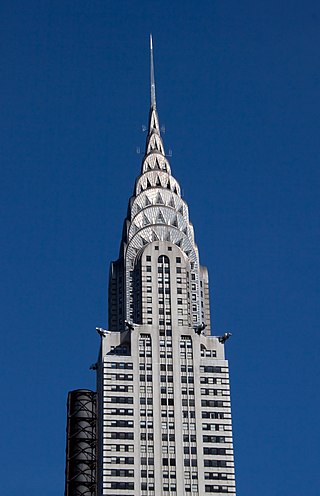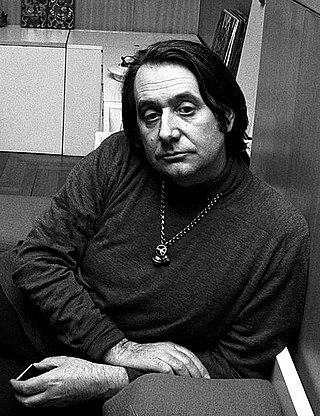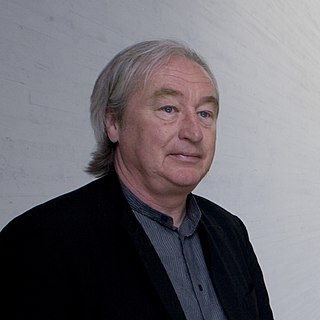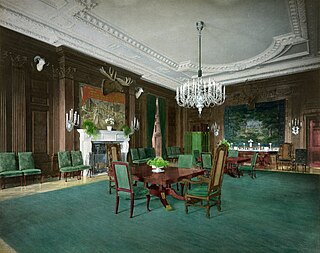Related Research Articles

Art Deco, short for the French Arts Décoratifs, and sometimes just called Deco, is a style of visual arts, architecture, and product design, that first appeared in France in the 1910s, and flourished in the United States and Europe during the 1920s and 1930s. Through styling and design of the exterior and interior of anything from large structures to small objects, including how people look, Art Deco has influenced bridges, buildings, ships, ocean liners, trains, cars, trucks, buses, furniture, and everyday objects like radios and vacuum cleaners.

Michael Graves was an American architect, designer, and educator, and principal of Michael Graves and Associates and Michael Graves Design Group. He was a member of The New York Five and the Memphis Group – and a professor of architecture at Princeton University for nearly forty years. Following his own partial paralysis in 2003, Graves became an internationally recognized advocate of health care design.

Ettore Sottsass was a 20th century Italian architect, noted for also designing furniture, jewellery, glass, lighting, home and office wares, as well as numerous buildings and interiors — often defined by bold colours.
Haworth Inc. is a privately held, family-owned office furniture manufacturer headquartered in Holland, Michigan, United States. Founded in 1948 by G. W. Haworth, the company designs and manufactures furniture solutions including seating, tables, movable walls, panels, storage, and wood casegoods. Haworth's furniture pieces, combined with interior design and technology solutions, are intended to create a focus on “organic workspaces that help people perform their best.” Haworth employs 7,500 workers and has 650 dealerships in more than 120 countries. 2021 global sales reached $1.96 billion, a 6.2-percent increase from 2020.

Carrère and Hastings, the firm of John Merven Carrère and Thomas Hastings, was one of the outstanding American Beaux-Arts architecture firms. Located in New York City, the firm practiced from 1885 until 1929, although Carrère died in an automobile accident in 1911.

Florence Marguerite Knoll Bassett was an American architect, interior designer, furniture designer, and entrepreneur who has been credited with revolutionizing office design and bringing modernist design to office interiors. Knoll and her husband, Hans Knoll, built Knoll Associates into a leader in the fields of furniture and interior design. She worked to professionalize the field of interior design, fighting against gendered stereotypes of the decorator. She is known for her open office designs, populated with modernist furniture and organized rationally for the needs of office workers. Her modernist aesthetic was known for clean lines and clear geometries that were humanized with textures, organic shapes, and colour.

Steven Holl is a New York-based American architect and watercolorist.

Arthur Cotton Moore was an American architect who achieved national and international recognition for his contributions to architecture, master planning, furniture design, painting, and writing.

Artek is a Finnish furniture company. It was founded in December 1935 by architect Alvar Aalto and his wife Aino Aalto, visual arts promoter Maire Gullichsen and art historian Nils-Gustav Hahl. The founders chose a non-Finnish name: the neologism Artek was meant to manifest the desire to combine art and technology. This echoed a main idea of the International Style movement, especially the Bauhaus, to emphasize the technical expertise in production and quality of materials, instead of historical-based, eclectic or frivolous ornamentation.
Vladimir Kagan was an American furniture designer. He was inducted in the Interior Designer Hall of Fame in 2009, 62 years after he started designing and producing furniture.

Ronald John Rezek is a design entrepreneur who started five successful companies and has designed hundreds of contemporary light fixtures and ceiling fans. He is an expert on design patents and copyrights, and is often used as an expert witness in court.
Kravet Inc., is a home furnishings company established in 1918. This fifth generation family business distributes fabrics, furniture, wallcoverings, trimmings, carpets and accessories.
F. Schumacher & Co. is a privately held company based in New York City and Fort Mill, South Carolina, that designs products for the interior design industry in the United States. Established in 1889 by Frederic Schumacher, F. Schumacher & Co. is a fifth generation business and the only supplier of decorative textiles from the 19th century still privately owned and managed by direct descendants of its founder. The company sells fabric, wall covering, trimming, floorcovering, finished goods, paint, as well as print media, social and digital platforms under five brands, Schumacher, Patterson Flynn Martin, Backdrop, Freddie and Frederic. F. Schumacher & Co. currently maintains 18 showrooms in several countries and sells to the interior design trade.
Zahner or A. Zahner Company is an architectural metal & glass company located in Kansas City, Missouri.
Warren Platner was an American architect and interior designer.

A. H. Davenport and Company was a late 19th-century, early 20th-century American furniture manufacturer, cabinetmaker, and interior decoration firm. Based in Cambridge, Massachusetts, it sold luxury items at its showrooms in Boston and New York City, and produced furniture and interiors for many notable buildings, including The White House. The word "davenport," meaning a boxy sofa or sleeper-sofa, comes from the company.
Roche Bobois is a French company that designs and retails furniture and home accessories.

USM Modular Furniture is a Swiss manufacturer of modular furniture for the home and office. The company’s signature product line, USM Haller, is celebrated as a design classic and included in the permanent collection of the Museum of Modern Art and the Cooper-Hewitt National Design Museum. USM Modular Furniture employs a staff of 460 throughout Europe and the United States and is represented by more than 410 sales partners in 40 countries worldwide. USM has an international presence with furniture showrooms in Bern, Berlin, Hamburg, Düsseldorf, Munich, Paris, Stuttgart, Tokyo, and New York City. The company’s New York showroom and corporate offices are located at 28 Greene Street in SoHo.

Verna Cook Salomonsky (1890–1978) was a pioneering early 20th-century American architect known for her work as a solo practitioner in residential communities outside of New York in the 1920s and 1930s and later as an author on architectural design and history. Following the death of her first husband, Edgar Salomonsky, in 1929, she maintained her own practice and designed several hundred homes, including a model home for the New York World's Fair in 1939. In the 1960s, she and her second husband, Warren Butler Shipway, wrote several books on Mexican domestic architecture and design.
Nienkämper is a furniture manufacturer founded by Klaus Nienkämper in 1968. The North American company operates a 120,000-square-foot factory in Toronto's east end that produces furniture for office, residential, institutional and hospitality applications with showrooms in Toronto, New York, Chicago and Dallas.
References
- ↑ Architectural Record, July–August, 1977
- ↑ U.S. Patent No. Des. 322,371, December 17, 1991; U. S. Patent Office, Washington, D.C.
- ↑ U.S. Patent No. Des. 327,184, June 23, 1992; U.S. Patent Office, Washington, D.C.
- ↑ ”Pace Maker,” Architectural Record, April 1986.
- ↑ U.S. Patent No. Des. 289,710, U. S. Patent Office, Washington, D.C.
- ↑ U.S. Patent No. Des. 289,476, U.S. Patent Office, Washington, D.C.
- ↑ “Setting the Pace,” by Marilyn Bethany, New York, January 20, 1986. P.44-46.